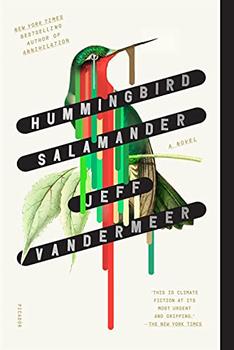Summary | Excerpt | Reviews | Beyond the book | Read-Alikes | Genres & Themes | Author Bio

In Hummingbird Salamander, Jeff VanderMeer weaves cybersecurity, bioterrorism, wildlife trafficking and climate change into a cryptic story. While the book includes hallmarks of dystopian fiction, its bizarre events unfold in a world that is eerily relatable to our current moment, sitting in a liminal space between dystopia and reality.
The novel is set in the Pacific Northwest and is related in the first person by a woman who refers to herself as "Jane Smith." As readers, we never learn her true identity. Jane also anonymizes other characters, including her husband and daughter. Early on in the book, it becomes evident that she is a cybersecurity professional who is discerning about what details she passes on to the reader, and when. As she tells her story, she dispenses information in short, shotgun-like bursts that feel disjointed but are at times disarmingly candid.
Although the narrative style takes some getting used to, VanderMeer makes it work. Jane's jarringly sharp accounts oscillate between different points in her past, including the novel's main events and memories of her childhood and teenage years. While the text is clipped in tone, it is rich in detail — when Jane sees it worthwhile to provide it to the reader — and action-packed. The result is a thriller full of carefully plotted switchbacks and twists, some of which are better hidden than others.
Hummingbird Salamander is best read with little or no knowledge of the plot, but a few details can be shared without giving too much away. The novel opens with Jane stopping for her morning coffee at her usual café, where the barista hands her an envelope containing a key, an address and the number seven. Jane goes to the address, which turns out to be a storage facility, and the key opens unit number seven. Inside, she discovers a taxidermied hummingbird and the words "Hummingbird Salamander." She quickly investigates and finds that the hummingbird is the last of an extinct species. The bird serves as the first in a set of clues left for Jane by the enigmatic Silvina Vilcapampa, an environmental activist and the daughter of a wealthy Argentine industrialist. It is not clear why Silvina has given the bird to Jane, but the puzzle surrounding it parallels Jane's work in cybersecurity, which she describes as follows:
A kind of scam, but also like detective work – figuring out how companies worked instead of how they said they worked. Found the security gaps. Sold the fear of security gaps. There would always be security gaps…Clients knew me as a "vulnerability assessor" or "vulnerability analyst." If I could figure out how to compromise their security systems or flaws in the human element, I could learn how to save them too.
As she follows the trail of evidence, Jane becomes more of a detective than a security professional, and becomes increasingly obsessed with the hummingbird and Silvina, an obsession that begins to eclipse her professional and personal lives. The stakes rise when it becomes clear that Jane and her family may be in danger as she continues to dig into Silvina's clues, which appear to be a sort of manifesto of environmentalism.
In Hummingbird Salamander, readers are confronted with the physicality and fragility of both the natural environment and human existence, as well as how the latter exploits the former. Jane describes herself as a large woman who dabbled in amateur bodybuilding and wrestling in her youth; she increasingly relies on her bodily strength as the plot moves her away from working in a digital world to investigating the contradictions of analog existence. Through this investigation, Jane takes the reader on a journey of environmental decline that includes climate change, animal extinction and pandemics. The story is simultaneously comparable to our present world and one step closer to environmental ruin in a plausible warping of reality that will be familiar to fans of VanderMeer's Southern Reach Trilogy (Annihilation, Authority and Acceptance).
Hummingbird Salamander is disconcerting throughout. It raises existential questions that will niggle at the backs of readers' minds while they are carried along with the swiftly moving plot, making for an engrossing read that unquestionably earns its stripes as a thriller.
![]() This review was originally published in The BookBrowse Review in April 2021, and has been updated for the
April 2022 edition.
Click here to go to this issue.
This review was originally published in The BookBrowse Review in April 2021, and has been updated for the
April 2022 edition.
Click here to go to this issue.

If you liked Hummingbird Salamander, try these:

by Jeff VanderMeer
Published 2025
The surprise fourth volume in Jeff VanderMeer's Southern Reach series―and the final word on one of the most provocative and popular speculative fiction series of our time.

by Soyoung Park, Joungmin Lee Comfort
Published 2025
In a world of constant winter, only the citizens of the climate-controlled city of Snowglobe can escape the bitter cold—but this perfect society is hiding dark and dangerous secrets within its frozen heart. A groundbreaking Korean novel translated into English for the first time!
Your guide toexceptional books
BookBrowse seeks out and recommends the best in contemporary fiction and nonfiction—books that not only engage and entertain but also deepen our understanding of ourselves and the world around us.